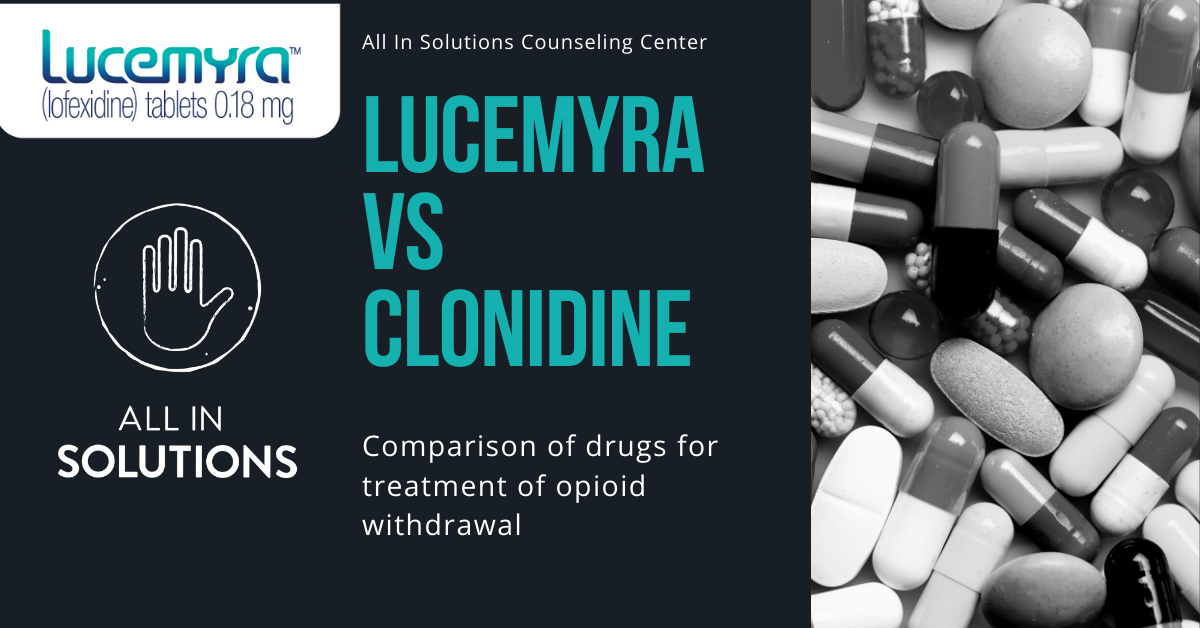Comparing Lucemyra vs Clonidine

When comparing Lucemyra vs. clonidine, there are a number of factors to consider. The former is an alternative to opioid agonists, and is FDA-approved to relieve the symptoms of opioid withdrawal. However, clonidine (generic for Catapres, Kapvay, and Nexiclon XR) can cause dangerously low blood pressure, which makes it a dangerous alternative for treating withdrawal symptoms. Lucemyra by contrast has a lower risk of low blood pressure.
The active drug in Lucemyra is lofexidine, which belongs to a class of drugs which targets the nervous system causing feelings of sedation, relaxation, and mild pain relief. Clonidine, on the other hand, acts on alpha-adrenergic and imidazoline receptor agonists and is actually used to treat hypertension. This anti-hypertensice property can limit its application as an opioid withdrawal medication.
While it may seem harmless, hypotension can cause serious problems, including fainting and falling. For this reason, it is best to discuss your concerns with your doctor, and make sure he or she understands your medical history before starting either medication. If you have any type of heart condition, you should discuss any problems with your doctor immediately. While lofexidine does carry some risk for hypotension, it is safer in this aspect than clonidine.
However, another important factor to consider when comparing Lucemyra vs. clonidine is its cost. Clonidine is significantly cheaper than Lucemyra. It is also much more likely to be readily available at any local pharmacy. There are of course also programs available to help individuals with the cost of their medication.
Both LUCEMEYRA and clonidine aim to reduce the withdrawal symptoms of opioids by blocking activity at the norepinephrine receptors which are overactive during opiate withdrawal. This is in contrast with the mechanism of action of more popular opioid use disorder medications like buprenorphine (Suboxone) and methadone.

Lucemyra vs Suboxone
Suboxone, Subutex, Zubsolv, and methadone all work by activating the same opioid receptors in the brain that addictive opioid drugs do. By activating these same receptors, they significantly minimize the symptoms associated with detoxification. Because they work directly on the neurotransmitters that instigate withdrawal, opioid agonists like buprenorphine produce lower peak scores for withdrawal symptoms than Lucemyra. But compared to methadone, withdrawal withdrawal symptoms resolved sooner with lofexidine. In addition, buprenorphine and methadone cause withdrawal themselves when they are discontinued.
This detoxification timeline associated with discontinuing opioid agonists can be a preventative factor for patients seeking to begin an extended-release naltrexone treatment like Vivitrol. This is because patients must be completely opioid free (including buprenorphine/methadone) for at least 7 days before they can receive a Vivitrol shot.
For these patients, utilizing a drug like Lucemyra or clonidine to manage withdrawal until the patient can receive extended-release naltrexone treatment can prevent relapse and also prevent unintended precipitated withdrawal. In these cases, patients did report less severe withdrawal symptoms using Lucemyra compared to clonidine.
Getting Medication Assisted Treatment for Opiod Use Disorder
This article originally appeared on allinsolutions.com.
If you or someone you love are struggling with an addiction to opioids or heroin, All In Solutions Counseling Center offers medication-assisted treatment programs that can help. These MAT programs are available for inpatient and outpatient clients at their Florida drug rehab and their New Jersey drug rehab. Contact All In Solutions Counseling Center today to learn more about how they can help.
